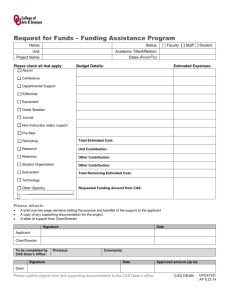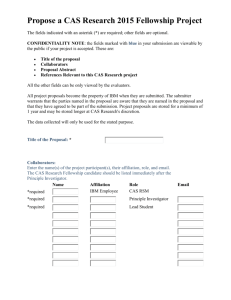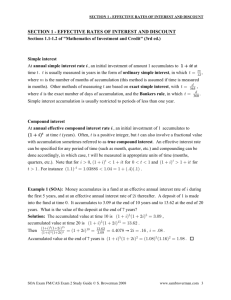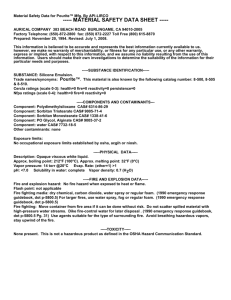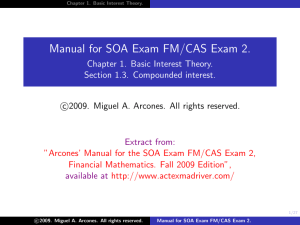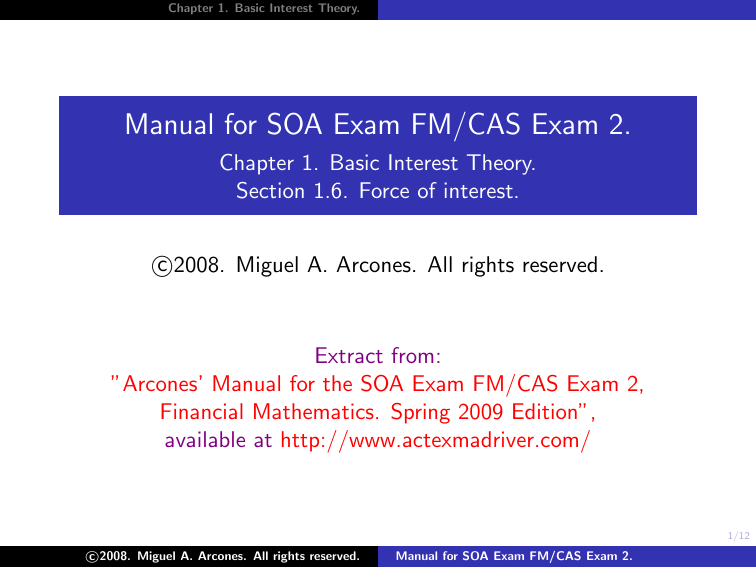
Chapter 1. Basic Interest Theory.
Manual for SOA Exam FM/CAS Exam 2.
Chapter 1. Basic Interest Theory.
Section 1.6. Force of interest.
c
2008.
Miguel A. Arcones. All rights reserved.
Extract from:
”Arcones’ Manual for the SOA Exam FM/CAS Exam 2,
Financial Mathematics. Spring 2009 Edition”,
available at http://www.actexmadriver.com/
1/12
c
2008.
Miguel A. Arcones. All rights reserved.
Manual for SOA Exam FM/CAS Exam 2.
Chapter 1. Basic Interest Theory.
Section 1.6. Force of interest.
Force of interest
The force of interest δt of an amount function A(t) is defined by
0 (t)
d
δt = dt
ln A(t) = AA(t)
.
2/12
c
2008.
Miguel A. Arcones. All rights reserved.
Manual for SOA Exam FM/CAS Exam 2.
Chapter 1. Basic Interest Theory.
Section 1.6. Force of interest.
Force of interest
The force of interest δt of an amount function A(t) is defined by
0 (t)
d
δt = dt
ln A(t) = AA(t)
.
The force of interest is the fraction of the instantaneous rate of
change of the accumulation function and the accumulation
function.
3/12
c
2008.
Miguel A. Arcones. All rights reserved.
Manual for SOA Exam FM/CAS Exam 2.
Chapter 1. Basic Interest Theory.
Section 1.6. Force of interest.
Force of interest
The force of interest δt of an amount function A(t) is defined by
0 (t)
d
δt = dt
ln A(t) = AA(t)
.
The force of interest is the fraction of the instantaneous rate of
change of the accumulation function and the accumulation
function.
To find the force of interest, we may use the accumulation
function,
d
d
d
d
ln A(t) =
ln(A(0)a(t)) =
ln(A(0)) +
ln(a(t))
dt
dt
dt
dt
d
= ln(a(t)).
dt
4/12
c
2008.
Miguel A. Arcones. All rights reserved.
Manual for SOA Exam FM/CAS Exam 2.
Chapter 1. Basic Interest Theory.
Section 1.6. Force of interest.
Example 1
Consider the amount function A(t) = 25 1 +
the force of interest equal of 0.5.
t 3
4 .
At what time is
5/12
c
2008.
Miguel A. Arcones. All rights reserved.
Manual for SOA Exam FM/CAS Exam 2.
Chapter 1. Basic Interest Theory.
Section 1.6. Force of interest.
Example 1
Consider the amount function A(t) = 25 1 +
the force of interest equal of 0.5.
t 3
4 .
At what time is
Solution: We have that
t 3
t
ln(A(t)) = ln 25 1 +
= ln 25 + 3 ln 1 +
.
4
4
The force of interest is
δt =
1
t d d
ln 25 + 3 ln 1 +
=3 4
ln(A(t)) =
dt
dt
4
1+
From the equation,
3
4+t
t
4
=
3
.
4+t
= 21 , we get that t = 2.
6/12
c
2008.
Miguel A. Arcones. All rights reserved.
Manual for SOA Exam FM/CAS Exam 2.
Chapter 1. Basic Interest Theory.
Section 1.6. Force of interest.
The force of interest is also called the rate of interest
continuously compounded and the continuous interest rate.
We have that
A(t + h) − A(t)
h→0
A(t) · h
interest earned over the next h years
= lim
.
h→0
investment at time t · h
δt = lim
The nominal annual rate earned in the next m1 years compounded
m times a year at time t is
m(a t + m1 − a(t))
a t + m1 − a(t)
=
.
a(t)
a(t) m1
We have that
lim
m→∞
a t+
1
m
− a(t)
a(t) m1
= δt .
7/12
c
2008.
Miguel A. Arcones. All rights reserved.
Manual for SOA Exam FM/CAS Exam 2.
Chapter 1. Basic Interest Theory.
Section 1.6. Force of interest.
Under compound interest, a(t) = (1 + i)t and
δt =
d
d
d
ln a(t) =
ln(1 + i)t = t ln(1 + i) = ln(1 + i)
dt
dt
dt
Under compound interest, the force of interest is a constant δ,
such that δ = ln(1 + i) = − ln ν.
Under compound interest,
lim i (m) = lim d (m) = δ.
m→∞
m→∞
In the case of simple interest, a(t) = 1 + it and
d
i
δt = dt
ln(1 + it) = 1+it
. The force of interest is decreasing with t.
8/12
c
2008.
Miguel A. Arcones. All rights reserved.
Manual for SOA Exam FM/CAS Exam 2.
Chapter 1. Basic Interest Theory.
Section 1.6. Force of interest.
From the force of interest δt , we may find the accumulation
function a(t), using
Theorem 2
For each t ≥ 0, a(t) = e
Rt
0
δs ds
.
9/12
c
2008.
Miguel A. Arcones. All rights reserved.
Manual for SOA Exam FM/CAS Exam 2.
Chapter 1. Basic Interest Theory.
Section 1.6. Force of interest.
From the force of interest δt , we may find the accumulation
function a(t), using
Theorem 2
For each t ≥ 0, a(t) = e
Rt
0
δs ds
.
Proof.
Since δs =
Z
d
ds
ln a(s) and a(0) = 1,
t
Z
δs ds =
0
So, a(t) = e
0
Rt
0
δs ds
t
t
d
ln a(s) ds = ln a(s) = ln a(t).
ds
0
.
10/12
c
2008.
Miguel A. Arcones. All rights reserved.
Manual for SOA Exam FM/CAS Exam 2.
Chapter 1. Basic Interest Theory.
Section 1.6. Force of interest.
Example 3
2
A bank account credits interest using a force of interest δt = t3t
3 +2 .
A deposit of 100 is made in the account at time t = 0. Find the
amount of interest earned by the account from the end of the 4–th
year until the end of the 8–th year.
11/12
c
2008.
Miguel A. Arcones. All rights reserved.
Manual for SOA Exam FM/CAS Exam 2.
Chapter 1. Basic Interest Theory.
Section 1.6. Force of interest.
Example 3
2
A bank account credits interest using a force of interest δt = t3t
3 +2 .
A deposit of 100 is made in the account at time t = 0. Find the
amount of interest earned by the account from the end of the 4–th
year until the end of the 8–th year.
Rt
Solution: First, we find a(t) = e 0 δs ds .
t
Z t
Z t
3s 2
3
δs ds =
ds = ln(s + 2) 3
0
0 s +2
0
3
t
+
2
= ln(t 3 + 2) − ln 2 = ln
2
and
t3 + 2
t3
=1+ .
2
2
The amount of interest earned in the considered period is
83
43
100(a(8) − a(4)) = (100) 1 +
− 1+
= 22400.
2
2
a(t) = e
Rt
0
δs ds
=e
ln
“
t 3 +2
2
”
=
12/12
c
2008.
Miguel A. Arcones. All rights reserved.
Manual for SOA Exam FM/CAS Exam 2.




